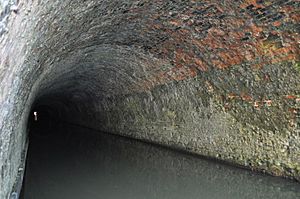Leicestershire and Northamptonshire Union Canal facts for kids
The Leicestershire and Northamptonshire Union Canal is a historic waterway in England. Today, it is an important part of the much larger Grand Union Canal. This canal helped connect different parts of England, making it easier to move goods and people.
Contents
What is the Leicestershire and Northamptonshire Union Canal?
This canal was planned a long time ago, in 1793. A special law, called an Act of Parliament, allowed it to be built. The main idea was to link the city of Leicester to the River Nene near Northampton. It was also meant to join another big canal project, the Grand Junction Canal.
Building the Canal: A Long Journey
Building canals was a huge task in the past. By 1809, the Leicestershire and Northamptonshire Union Canal was only finished from Leicester to Market Harborough. This meant it wasn't fully connected as planned.
Completing the Connection
The missing part of the canal was finished in 1810. This was done by a different company, the original Grand Union Canal Company. Their goal was to connect the canal at Foxton to the Grand Junction Canal at a place called Norton Junction. This completed the link, making the waterway much more useful. Later, in 1894, the Grand Junction Canal company bought this company.
Key Features of the Canal
The Leicestershire and Northamptonshire Union Canal is about 48 miles (77 kilometers) long. Along its path, you can find several interesting features:
- Locks: There are 22 locks. Locks are like water elevators that help boats move up or down between different water levels.
- Aqueduct: It has one aqueduct. An aqueduct is like a bridge that carries water, allowing the canal to cross over a valley or another river.
- Tunnel: There is also a tunnel called Saddington Tunnel. This tunnel is about half a mile (800 meters) long, cutting through a hill.


